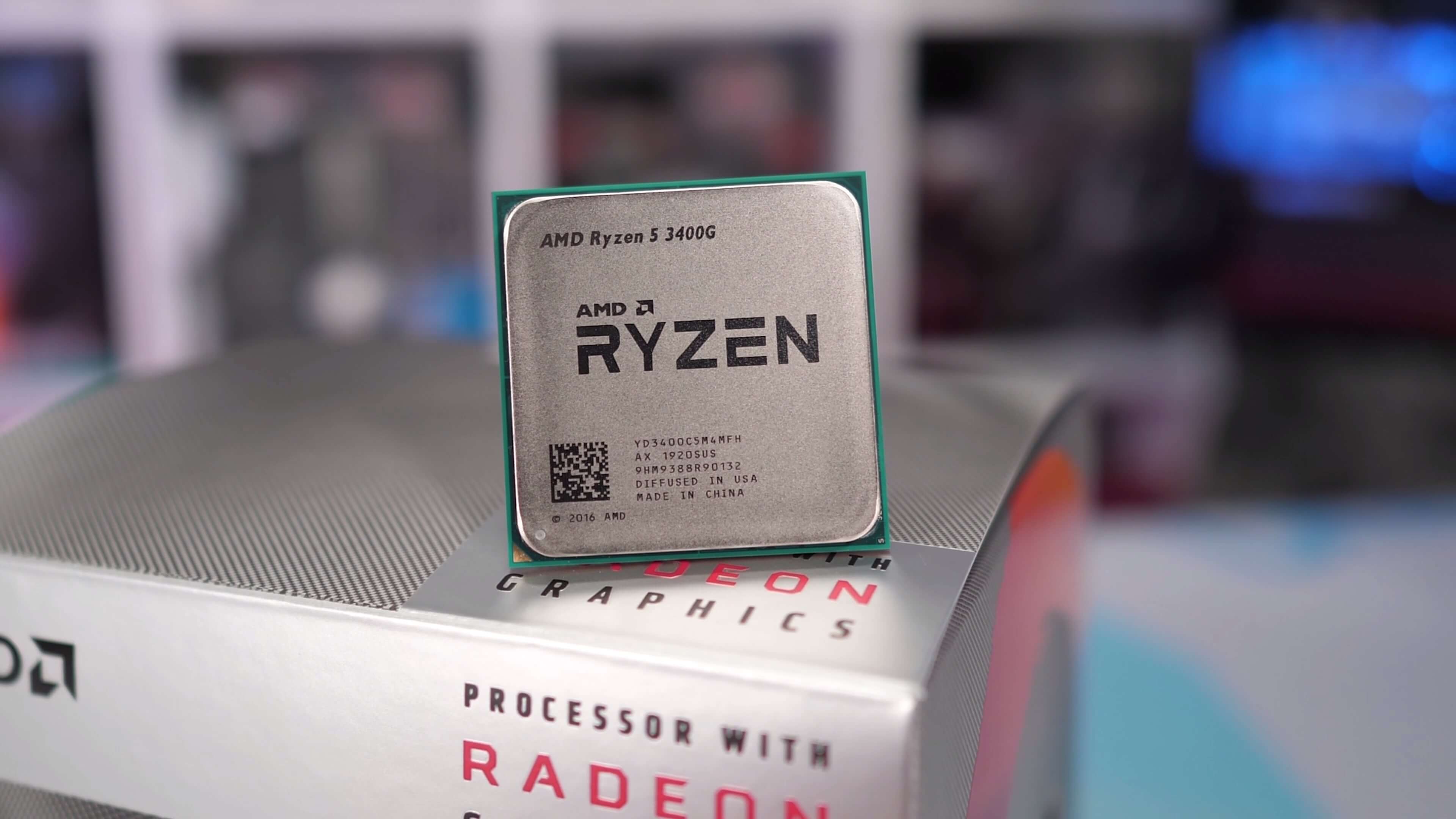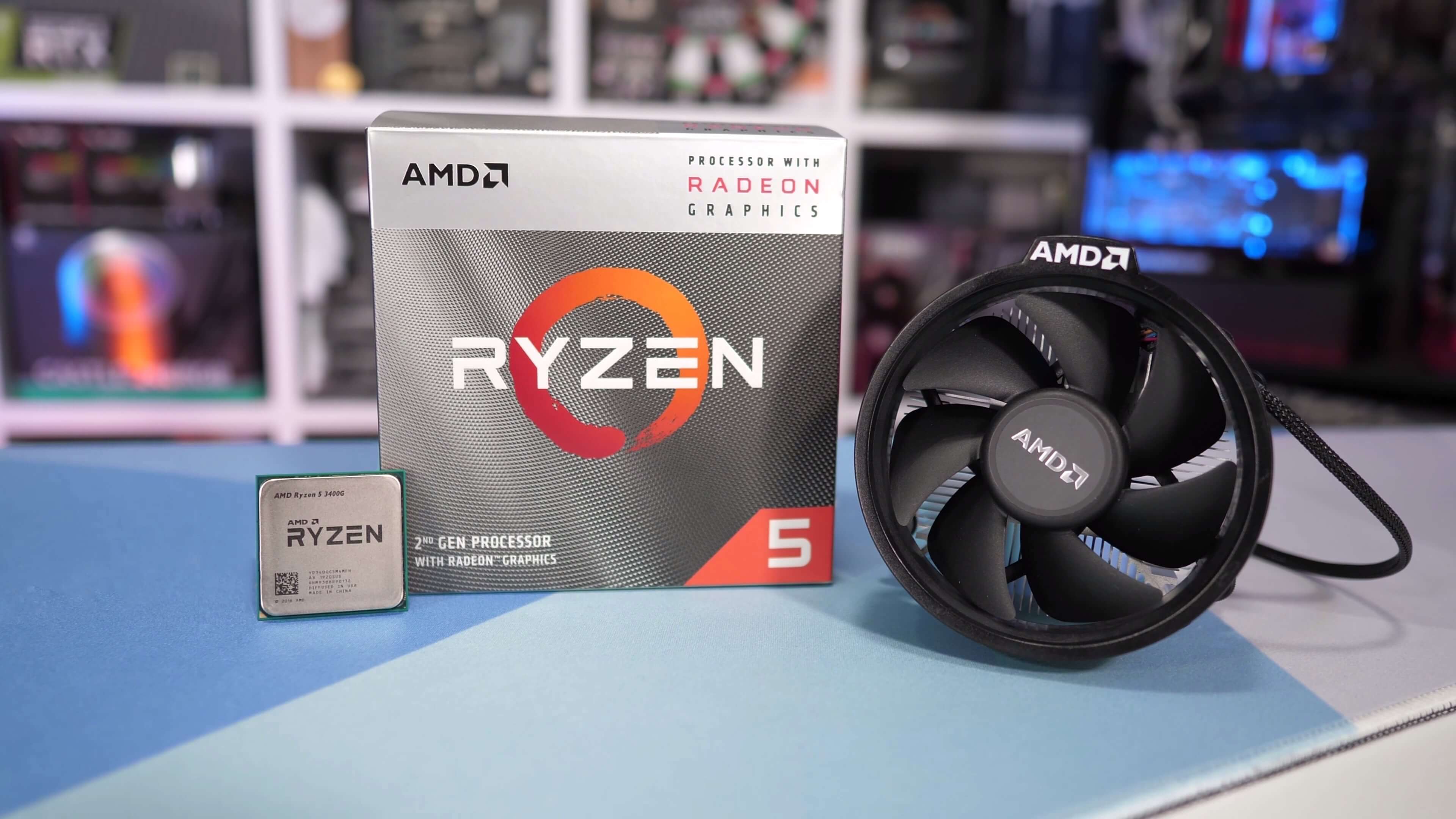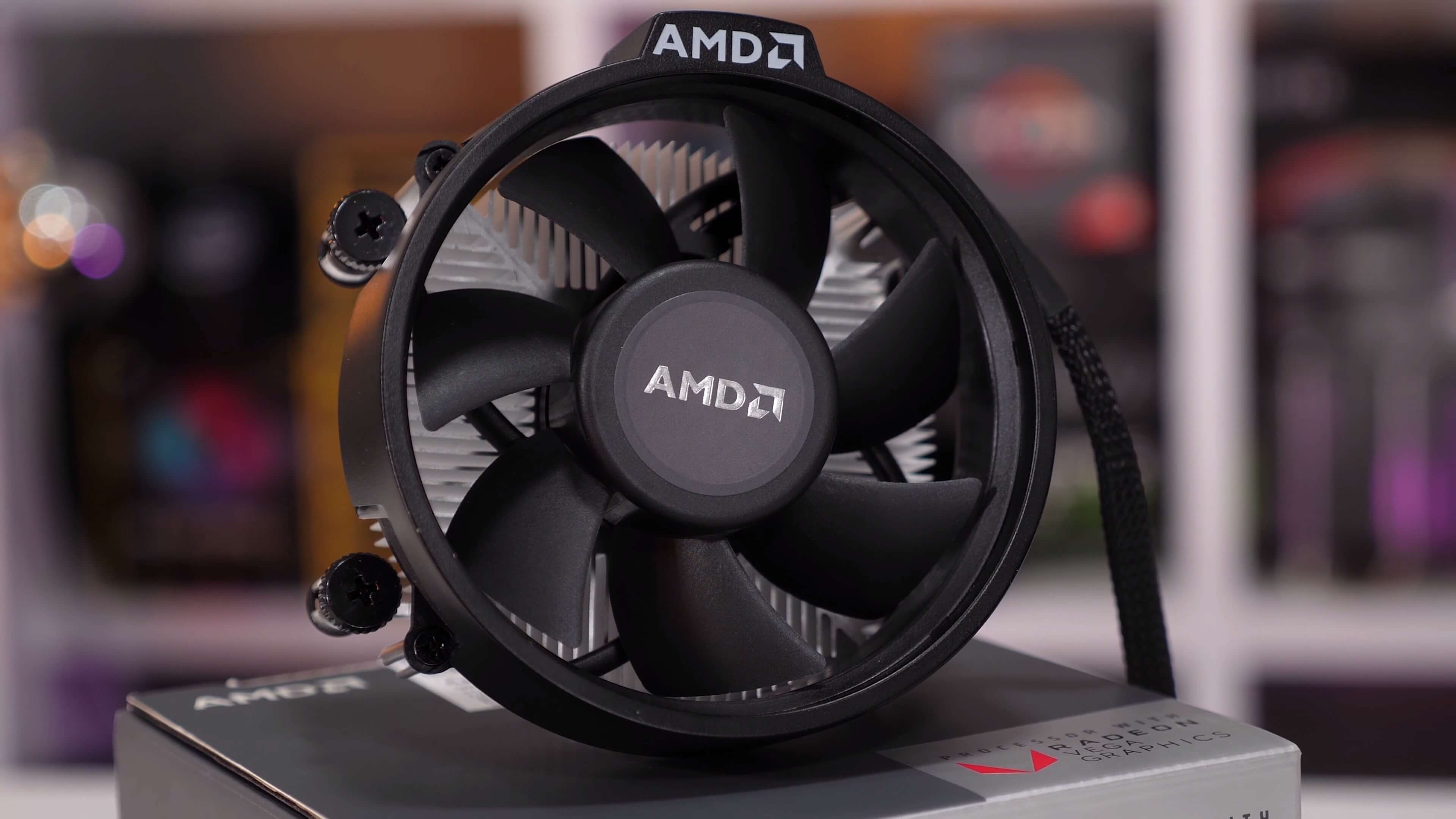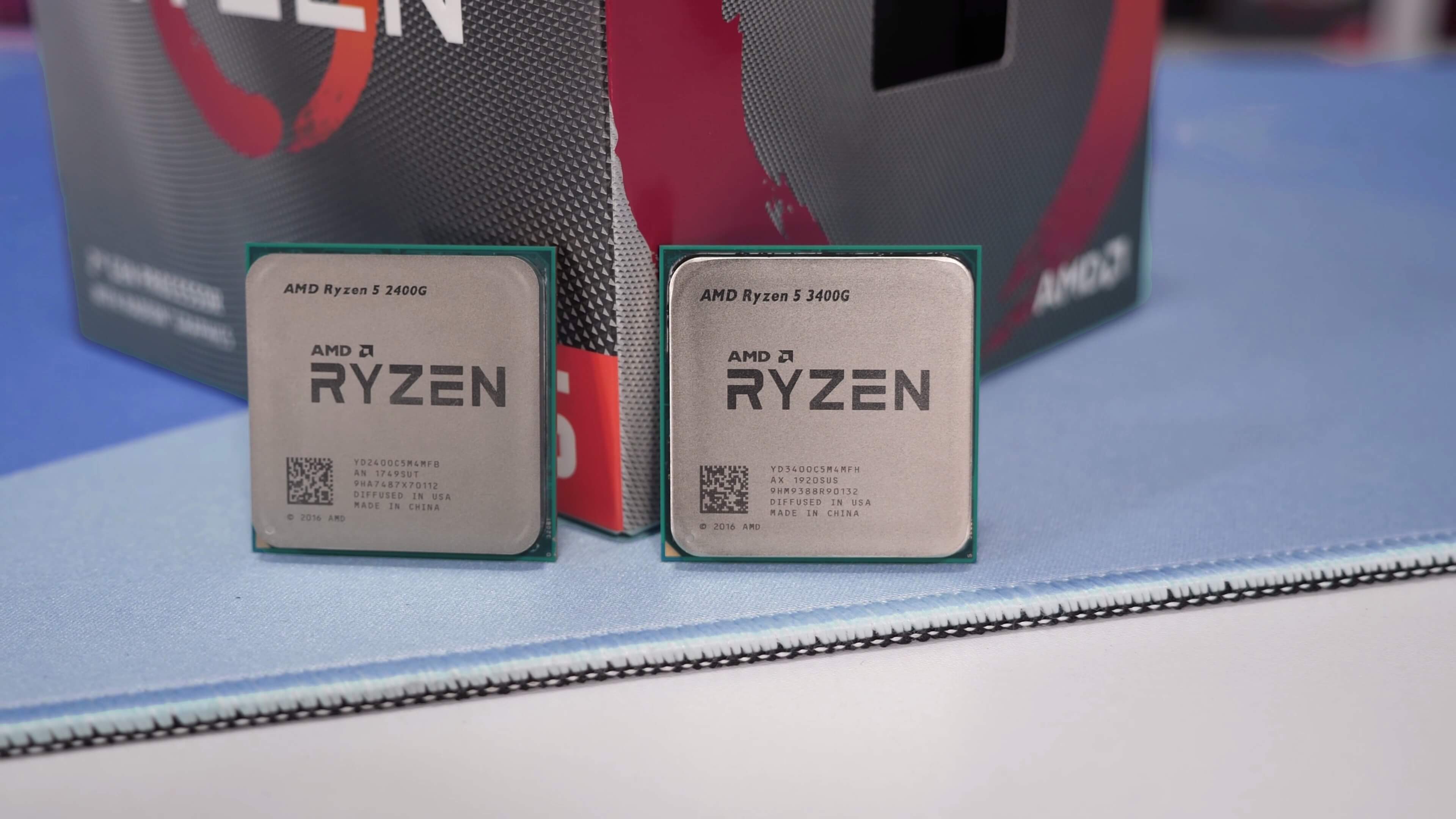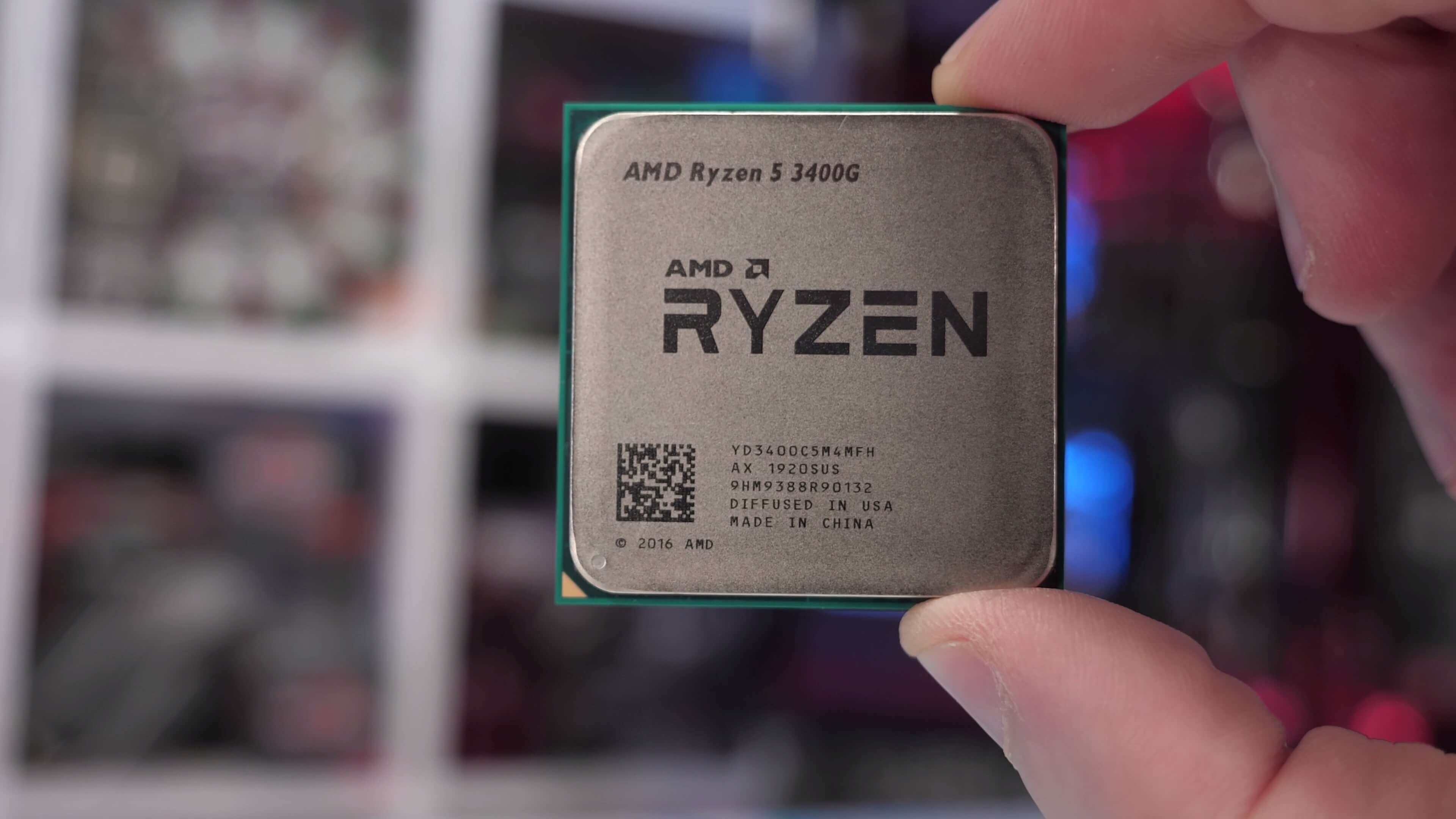As part of the big Zen 2 Ryzen processor launch, AMD released two Ryzen 3000 parts that include a graphics component. The new Ryzen 3 3200G and Ryzen 5 3400G APUs are straightforward upgrades compared to the models they replace, starting at $99 and $149 respectively.
AMD is using the Zen+ architecture, meaning these APUs are manufactured using the 12nm process, which offers improved clock speeds and thermals. The R5 3400G gets a cooler upgrade out of the box with the Wraith Spire, while the 3200G keeps the base Wraith Stealth. The 3400G also does away with the thermal paste interface material and it's soldered just like the big boy chips.
The 3400G CPU cores have been overclocked by 8% from 3.9 GHz to 4.2 GHz, while the Vega 11 graphics engine comes clocked at 1.4 GHz, a 12% boost from the 2400G. The price sticker has also received a slight discount with the R5 3400G starting at $149, or $20 lower than the 2400G at launch.
| Ryzen 3 2200G | Ryzen 5 2400G | Ryzen 3 3200G | Ryzen 5 3400G | |
| Launch Price | $99 | $169 | $99 | $149 |
| Cores/Threads | 4/4 | 4/8 | 4/4 | 4/8 |
| Base Clock | 3.5 GHz | 3.6 GHz | 3.6 GHz | 3.7 GHz |
| Boost Clock | 3.7 GHz | 3.9 GHz | 4.0 GHz | 4.2 GHz |
| Cache | 4MB | 4MB | 6MB | 6MB |
| GPU | Vega 8 @ 1100 MHz | Vega 11 @ 1250 MHz | Vega 8 @ 1250 MHz | Vega 11 @ 1400 MHz |
| TDP | 65W | 65W | 65W | 65W |
For testing this new APU we're using the MSI B450 Carbon Gaming with 16GB of DDR4-3200 memory. We won't be covering the APU from every angle like we did with the 2200G and 2400G as most of the information such as memory scaling is still relevant.
For now we want to see how different the 3400G is to the 2400G, and what kind of value proposition is on the table considering the Ryzen R5 3600 starts at just $200 and there's also the previous-gen 1600 and 2600 parts which can be found for even less – sans graphics, of course.
Application Benchmarks
The Cinebench R20 multi-core test shows the 3400G providing an 9% performance uplift from the 2400G model, largely due to that 8% increase in clock speed, and partly due to the improved IPC of Zen+. It's worth noting that the R5 3600 is 81% faster in this test while only costing 33% more, though it does lack integrated graphics. We'll discuss more about that later.
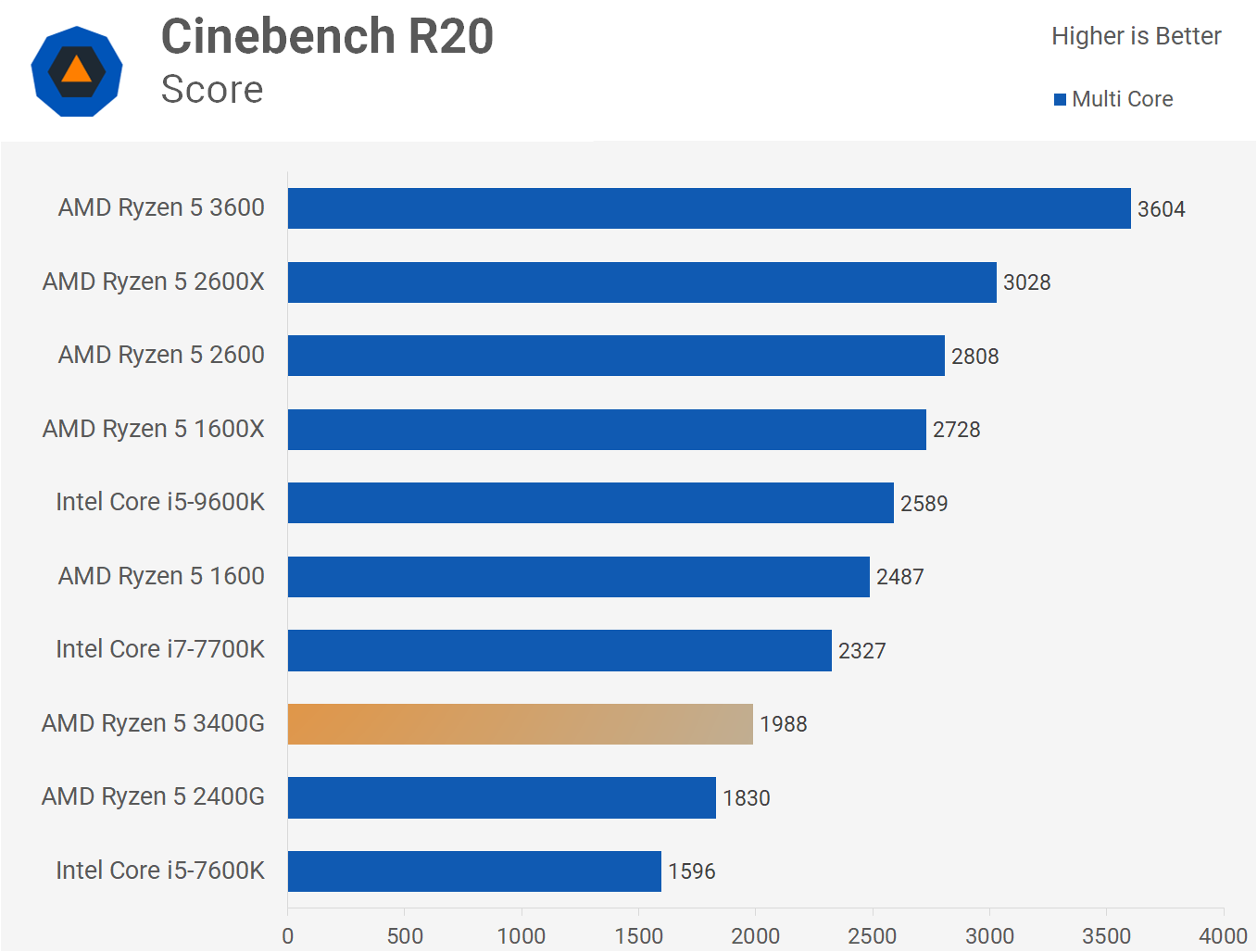
We see a ~10% improvement in single core performance thanks to the frequency boost and upgrade to Zen+. This placed the 3400G on par with the R5 2600X and this time the R5 3600 was just 15% faster as it's not able to put those extra cores to work in this test.
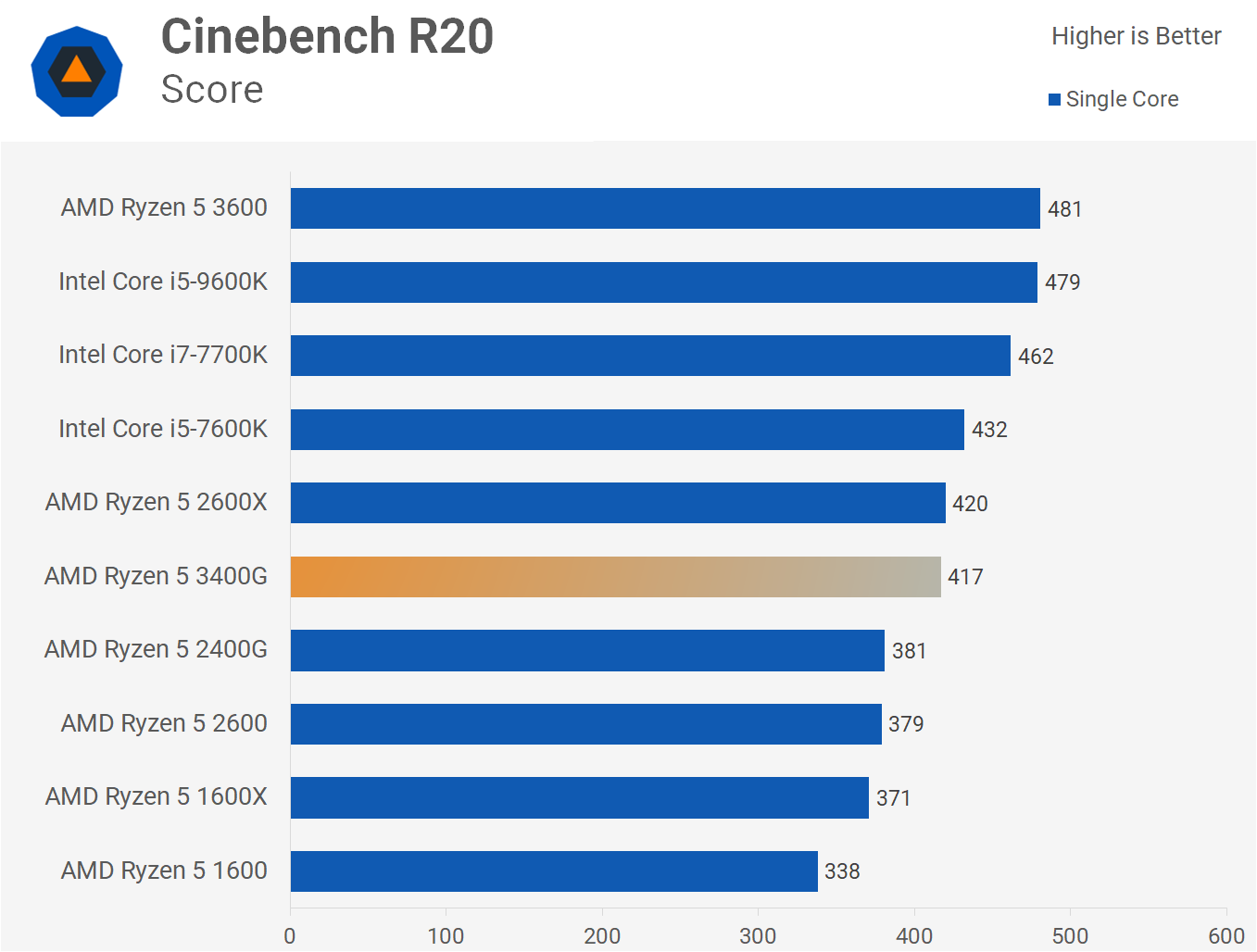
Memory bandwidth performance is much the same, Zen+ improves memory latency but as you can see in terms of bandwidth both sustained a transfer speed of 36 GB/s.

The 3400G was 10% faster than the 2400G in the 7-Zip compression test and while that's a decent little bump in a world where 6-core processors are now commonplace it doesn't look that impressive.
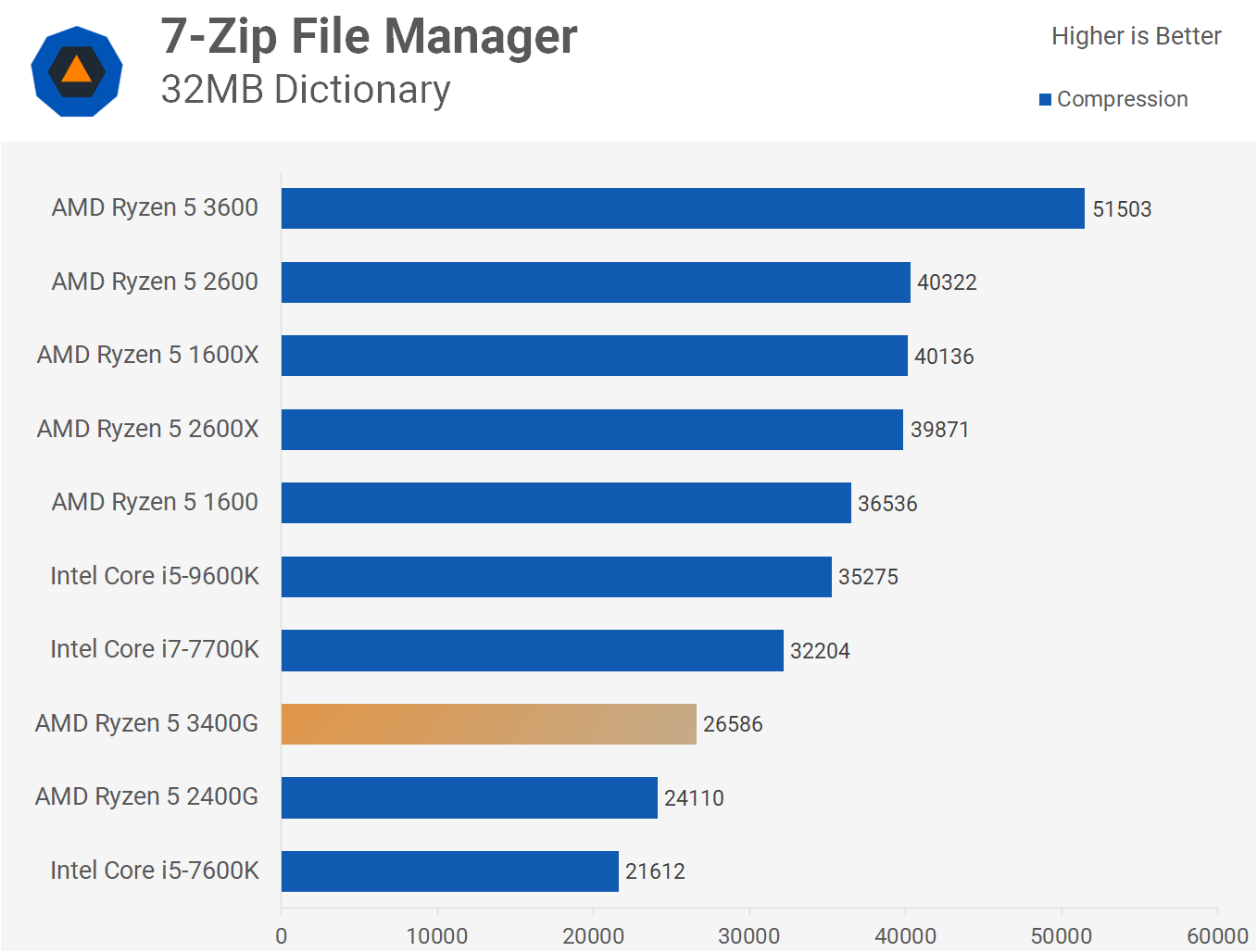
AMD's SMT implementation is very efficient when it comes to decompression work in 7-zip. As a result the 3400G beats the Core i7-7700K and wasn't a great deal slower than the 6-core/6-thread 9600K.
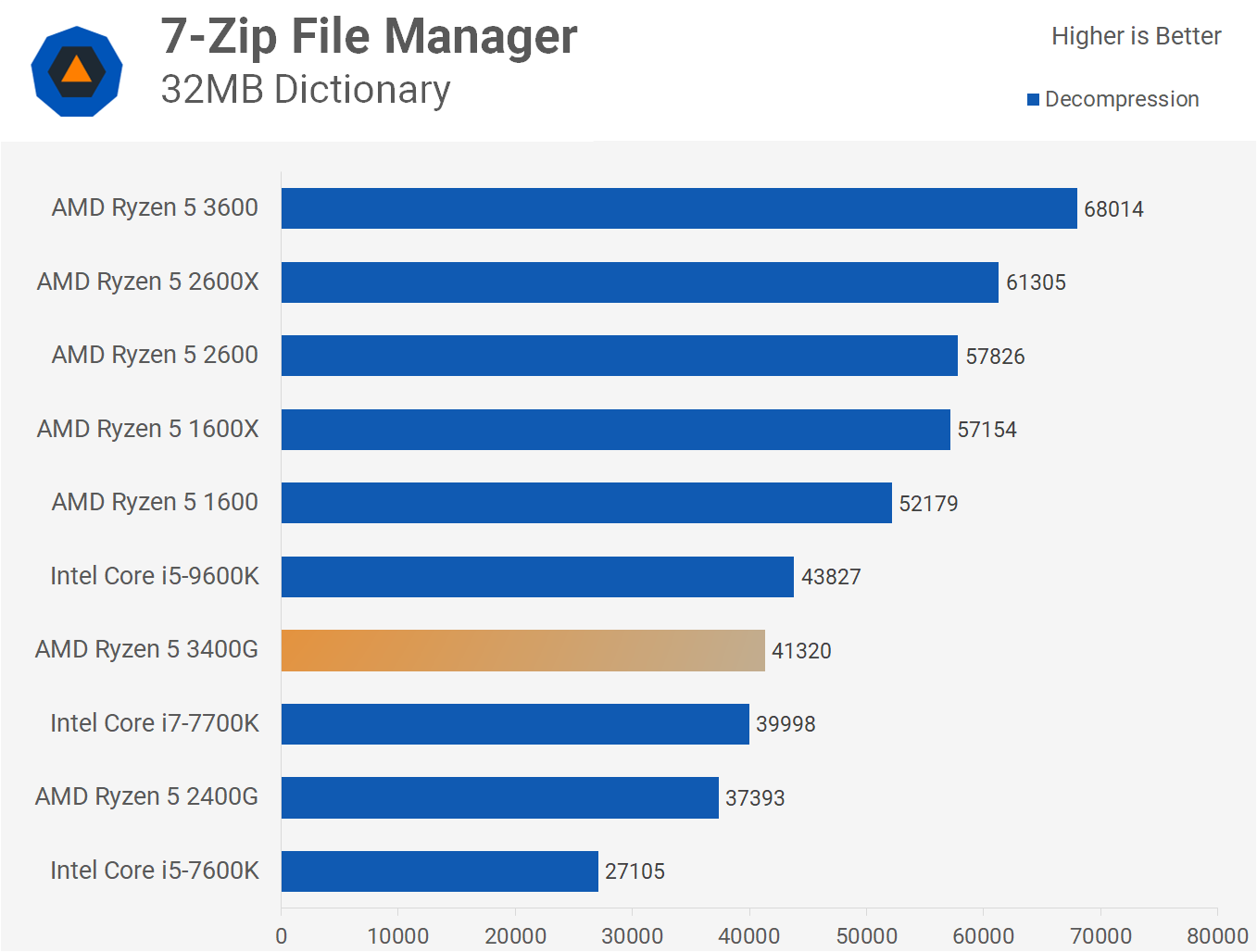
We've tested Premiere using two configurations: one with the GeForce RTX 2080 Ti, the standard graphics card used for testing CPUs, and then one using the intergrtated Vega 11 graphics for GPU acceleration.
With a highly capable discrete graphics card the 3400G is actually very impressive in this test, completing the render in just 629 seconds. However, without a graphics card it took 1762 seconds and that's not so great, if you were going to use this processor for video editing and encoding, buying an entry-level graphics card would be the way to go, or better yet just buy the R5 3600 and pair that with an entry-level graphics card.
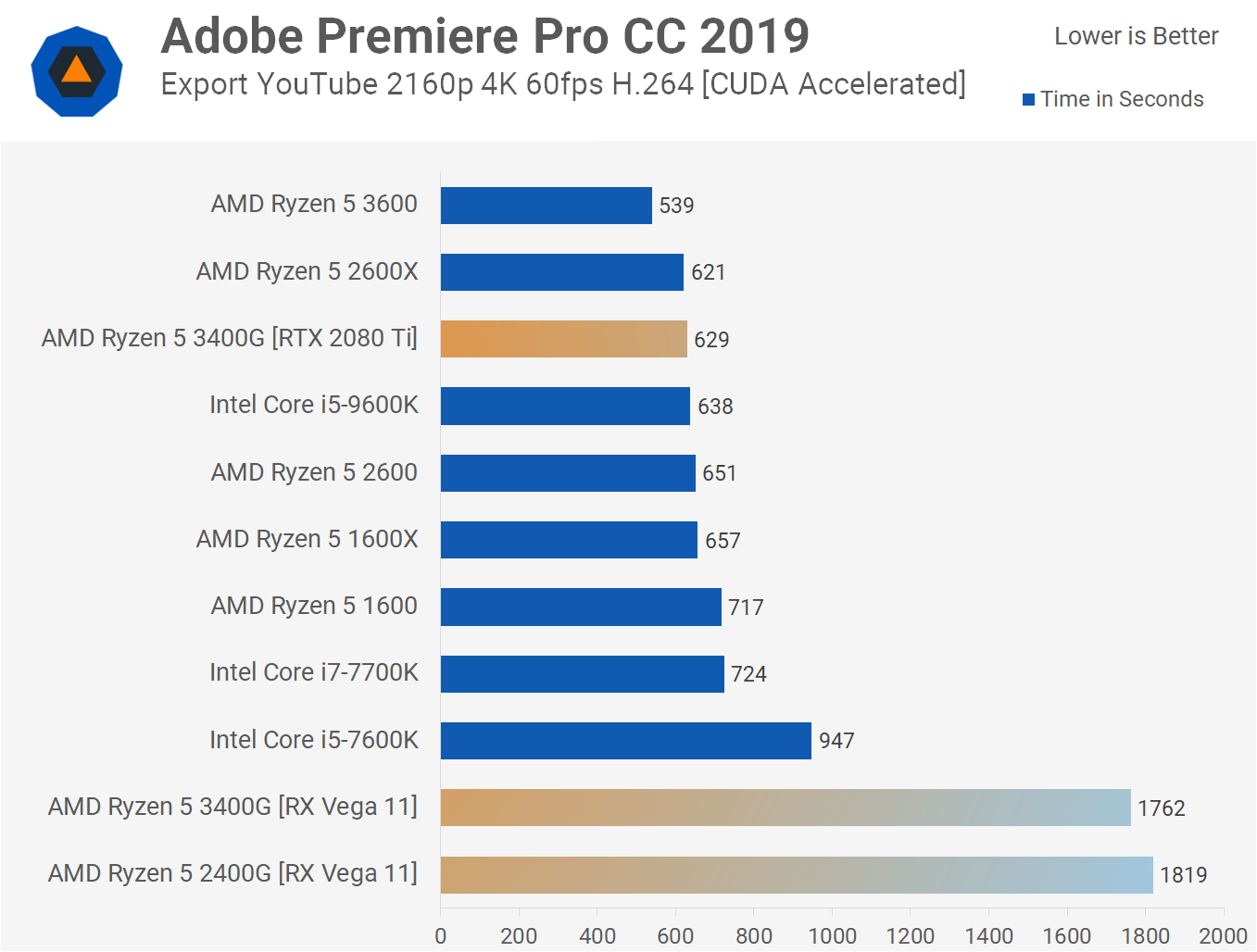
The 3400G was only 4% faster than the 2400G in the Corona benchmark and while that made both much faster than the Core i5-7600K, they were slower than everything else.
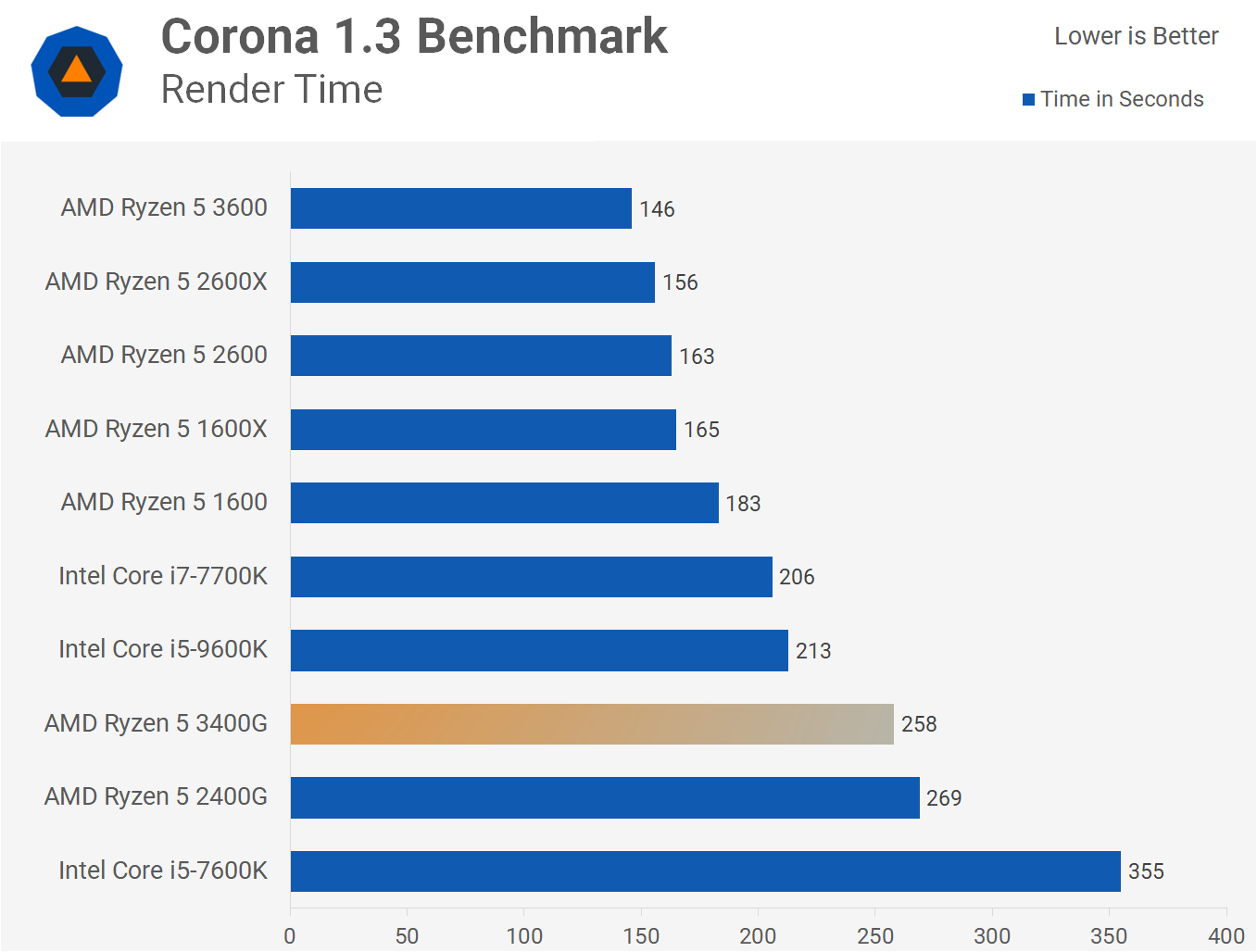
Similar margins are seen in the Blender Open Data benchmark, this time the 3400G offered a 6% performance boost over the 2400G and both trailed the 7700K.

Power Consumption
When it comes to power consumption the 3400G still sips power, pushing total consumption 10% higher than that of the 2400G and that meant system usage was 10% lower than what we saw with the 7600K.

Moving on to operating temperatures we see that the 3400G peaked at 58 degrees using the Wraith Spire box cooler when running the Blender test. Out of the box it sustained an operating frequency of 3950 MHz and when enabling PBO + AutoOC in the Ryzen Master software that didn't change.
When testing with F1 2019 the 3400G ran much cooler despite the Vega 11 graphics now being in use, here the CPU peaked at just 45 degrees and ran at 4025 MHz. Enabling PBO + AutoOC pushed the operating temperature up to 48 degrees and this time we did get a 100 MHz bump to the operating frequency.
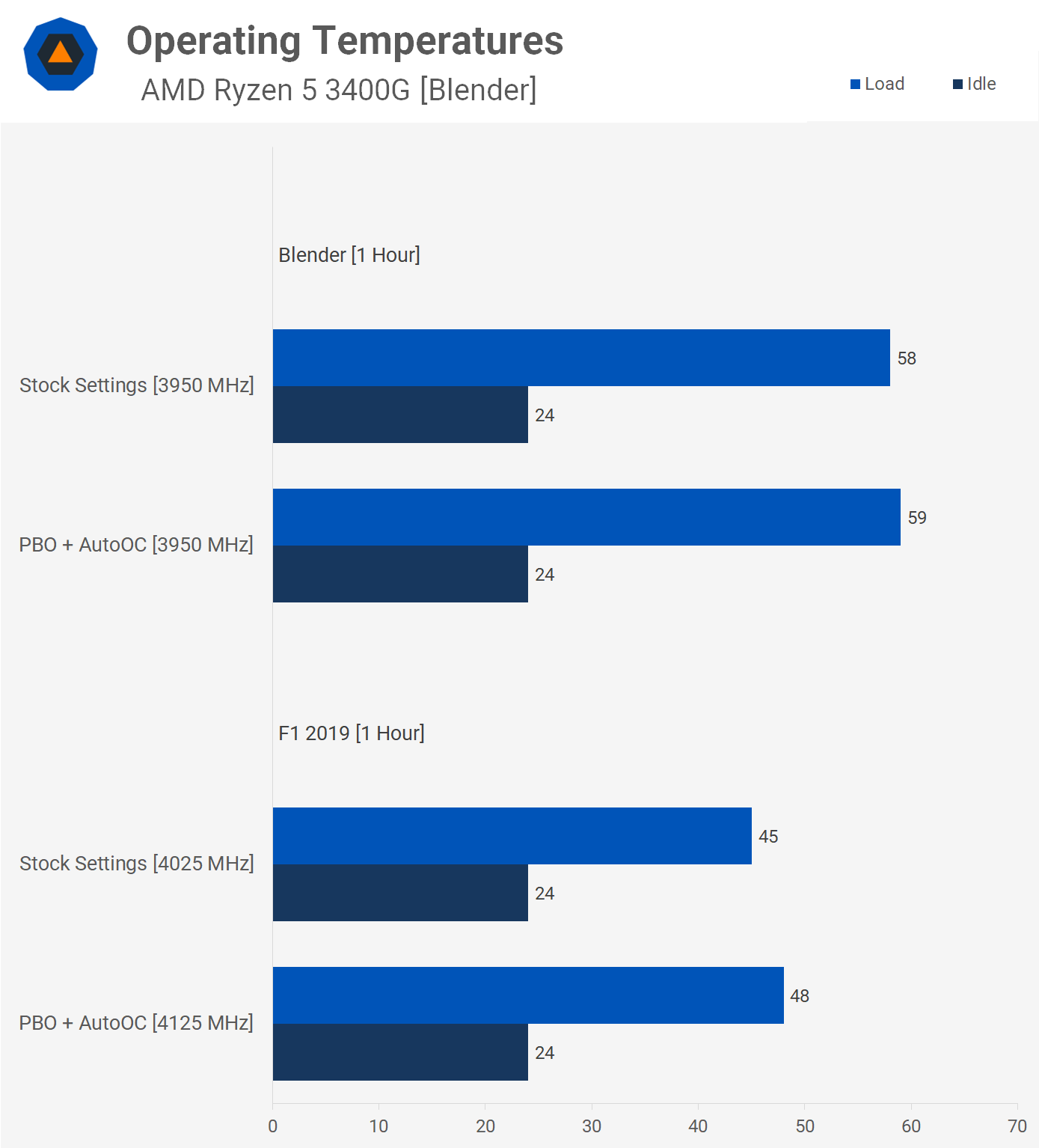
Gaming Benchmarks (with add-in GeForce GPU)
Before testing the integrated GPU, let's take a quick look at how the 3400G stacks up to other CPUs when comparing gaming performance without a GPU limitation.
At 1080p it's faster than the Core i5-7600K and not a great deal slower than the 6-core/12-thread R5 1600, moreover it provided an 11% boost over the 2400G. The 3400G is even more competitive at 1440p, situating itself between the R5 1600 and 1600X, not bad for budget processor.
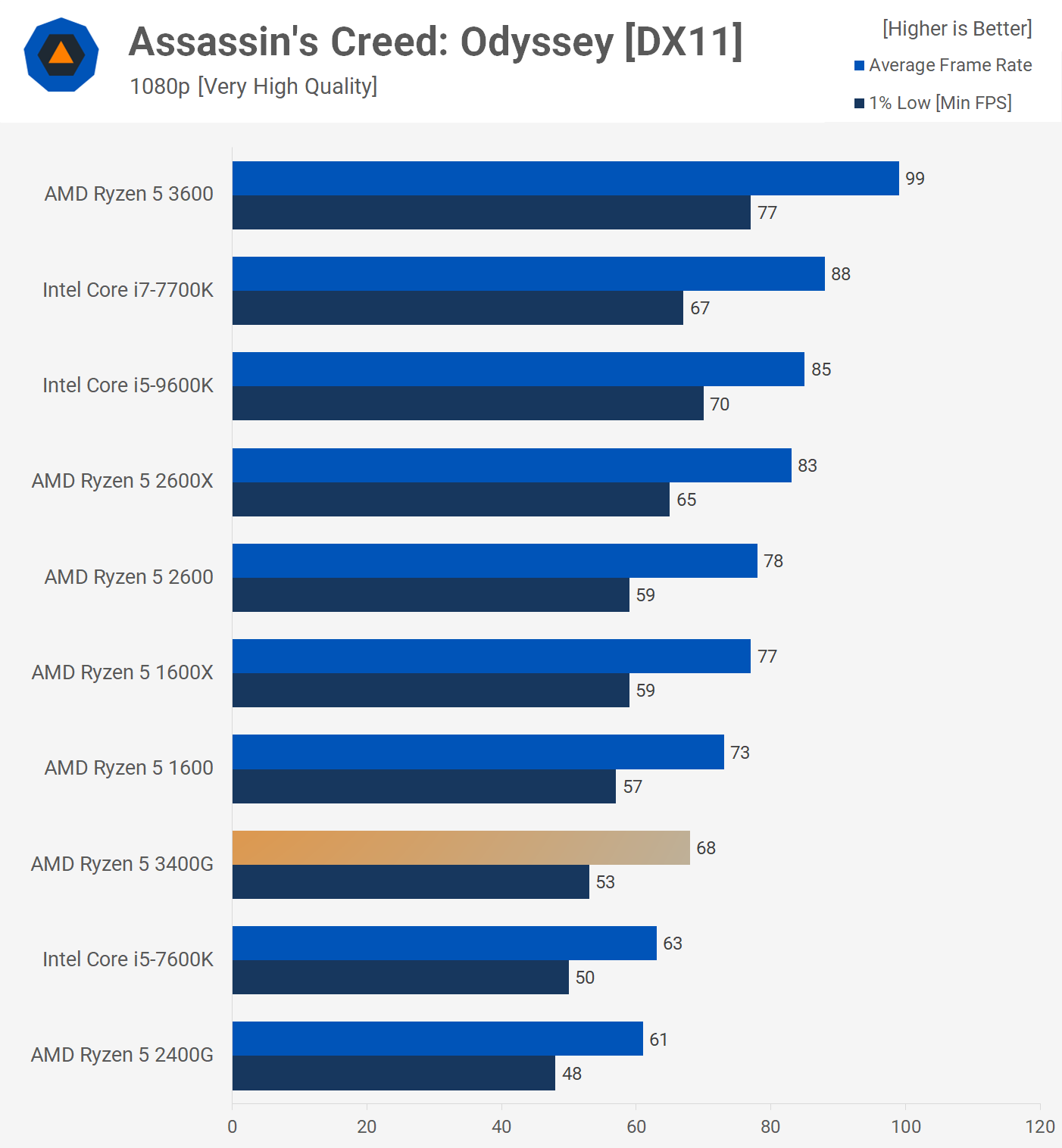
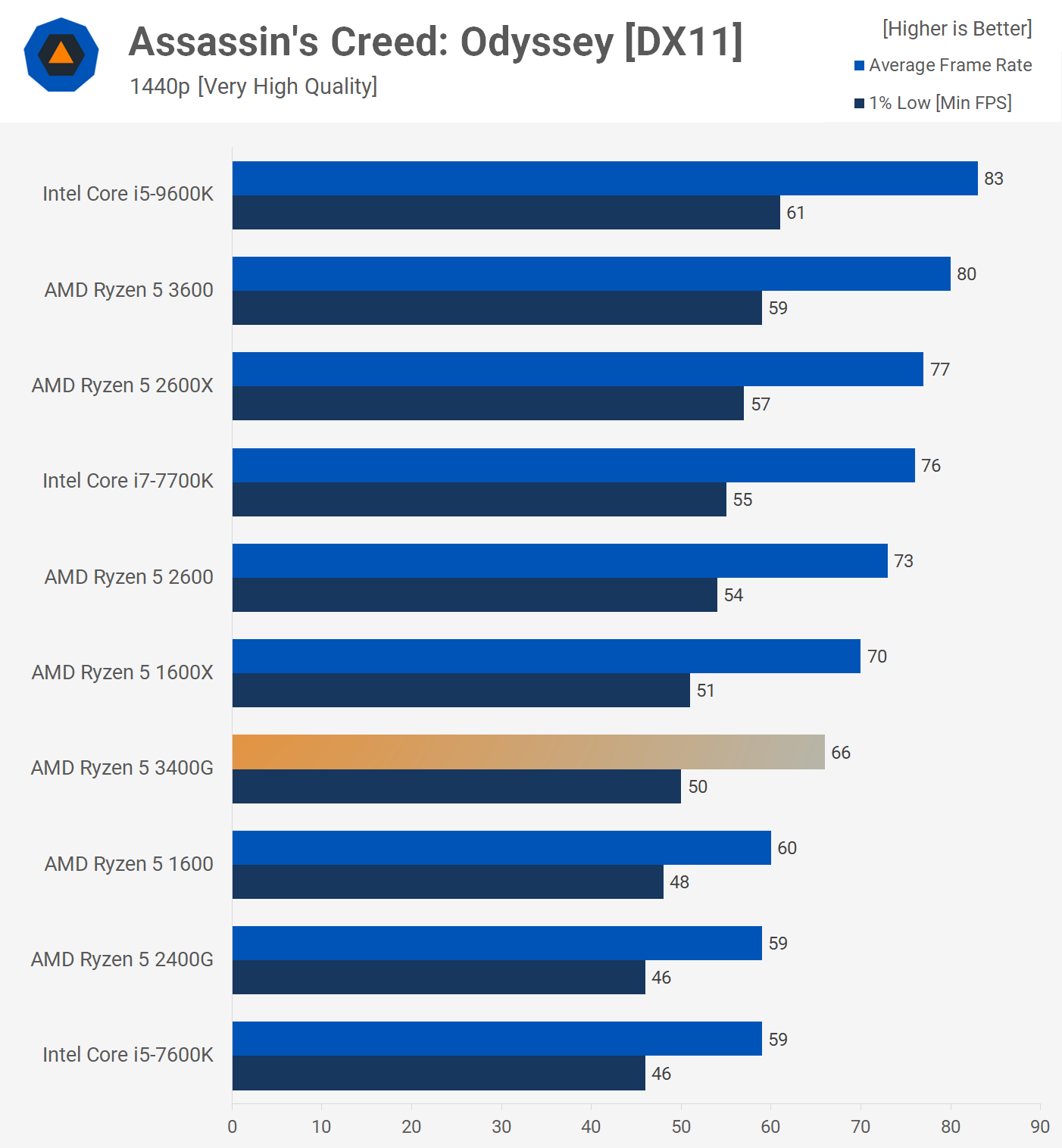
Performance in Battlefield V was respectable. For example, the 3400G mimicked the 1% low performance of the Core i7-7700K while the average was only slightly down on the R5 1600. This time the 3400G was up to 10% faster than the 2400G.
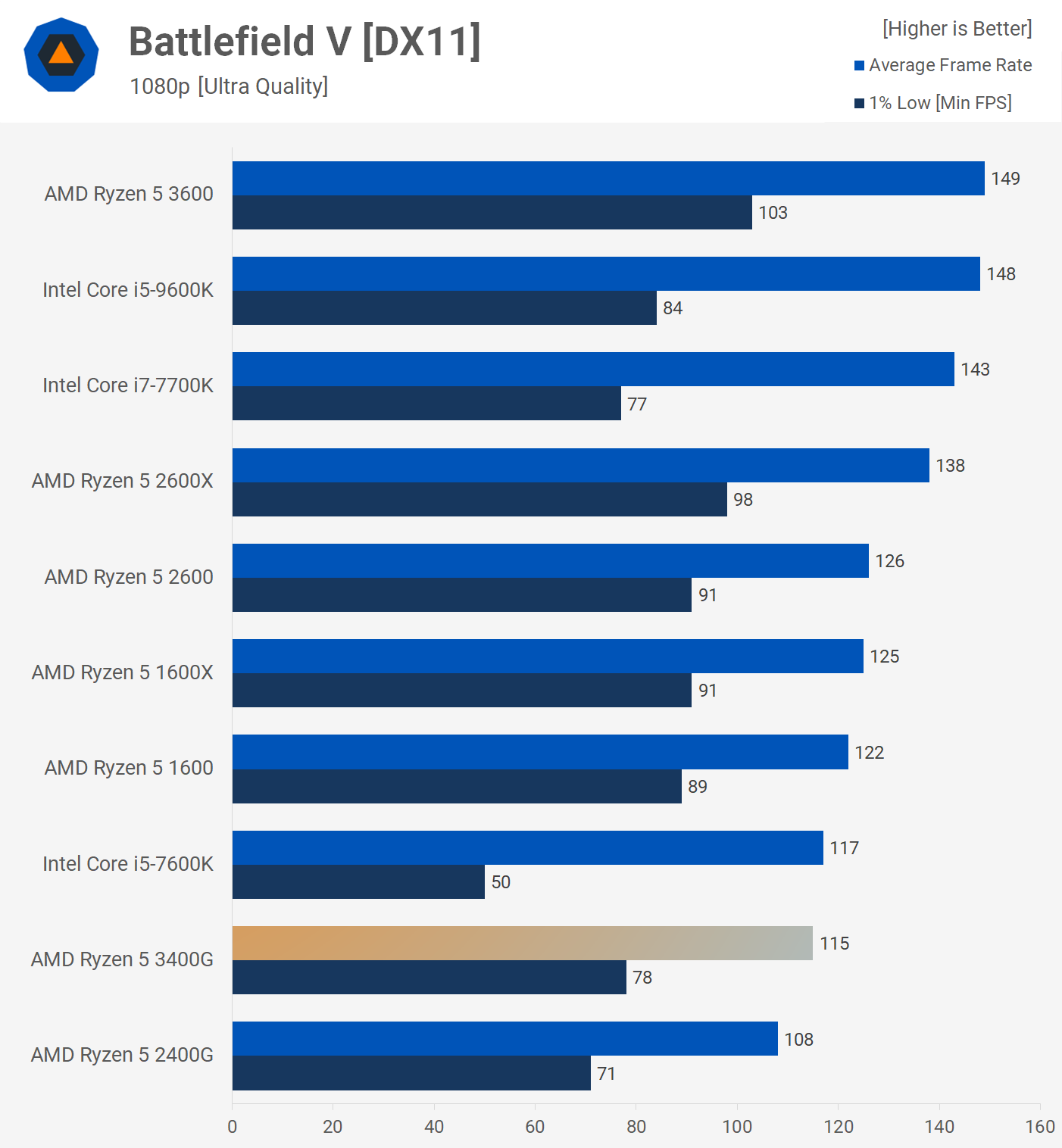
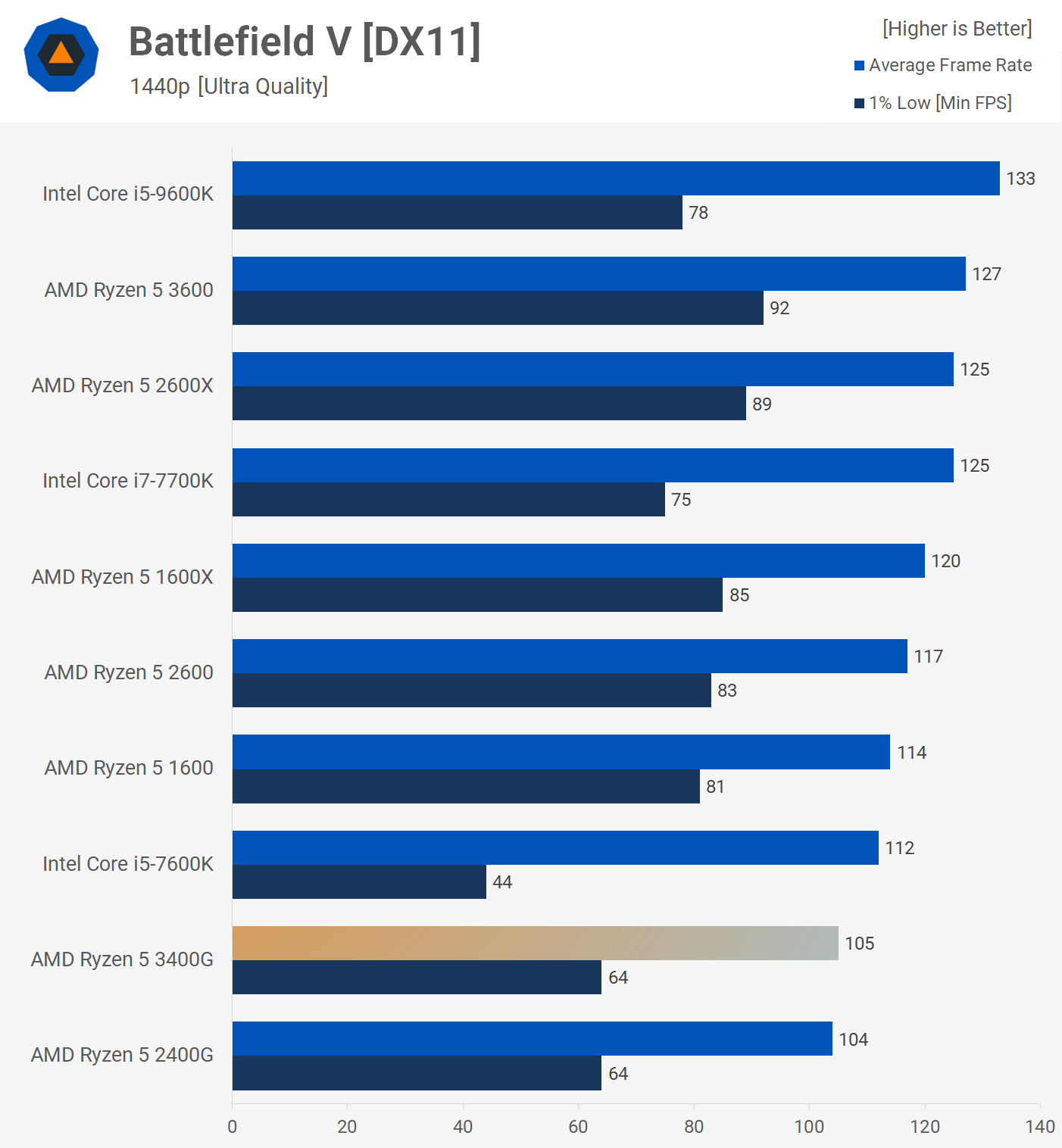
We found a similar result when testing with The Division 2, here the 3400G offers a 7% performance increase over the 2400G while trailing the R5 1600 by a 10% margin. The 3400G is still 8% faster than the 2400G at 1440p, but now it's able to close in on the 1% low performance of the R5 1600 and 1600X.
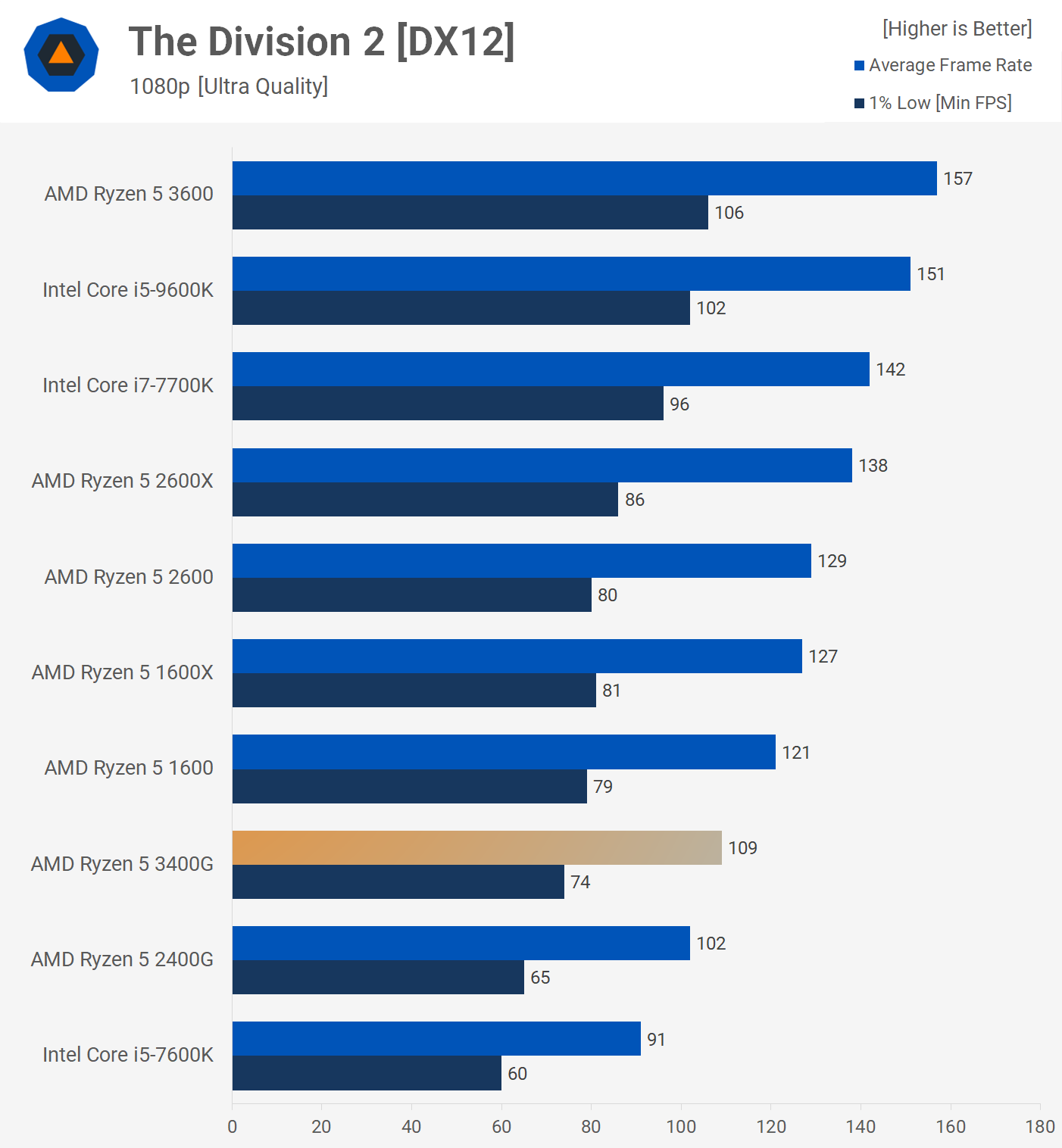
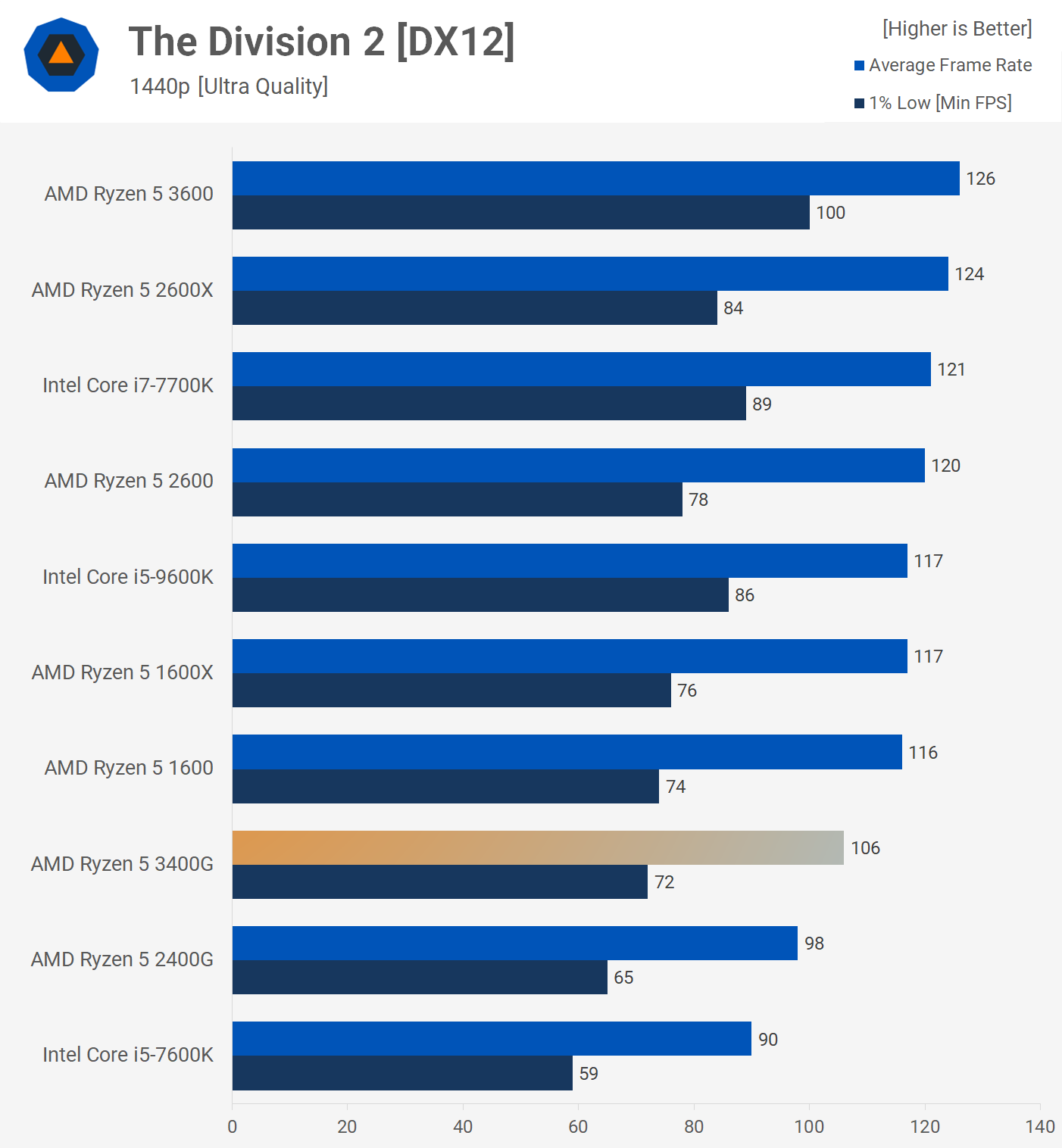
We see a pretty impressive result in Far Cry. At first you might think the 17% performance uplift over the 2400G is a mistake, but we assure you it's not. The improved cache and memory latency of the Zen+ architecture gives the 3400G a big advantage in Far Cry New Dawn, enough to match the R5 1600X.
The margin comes down a little at 1440p, but even so the 3400G was still 12% faster than the 2400G and once again matched the R5 1600X.
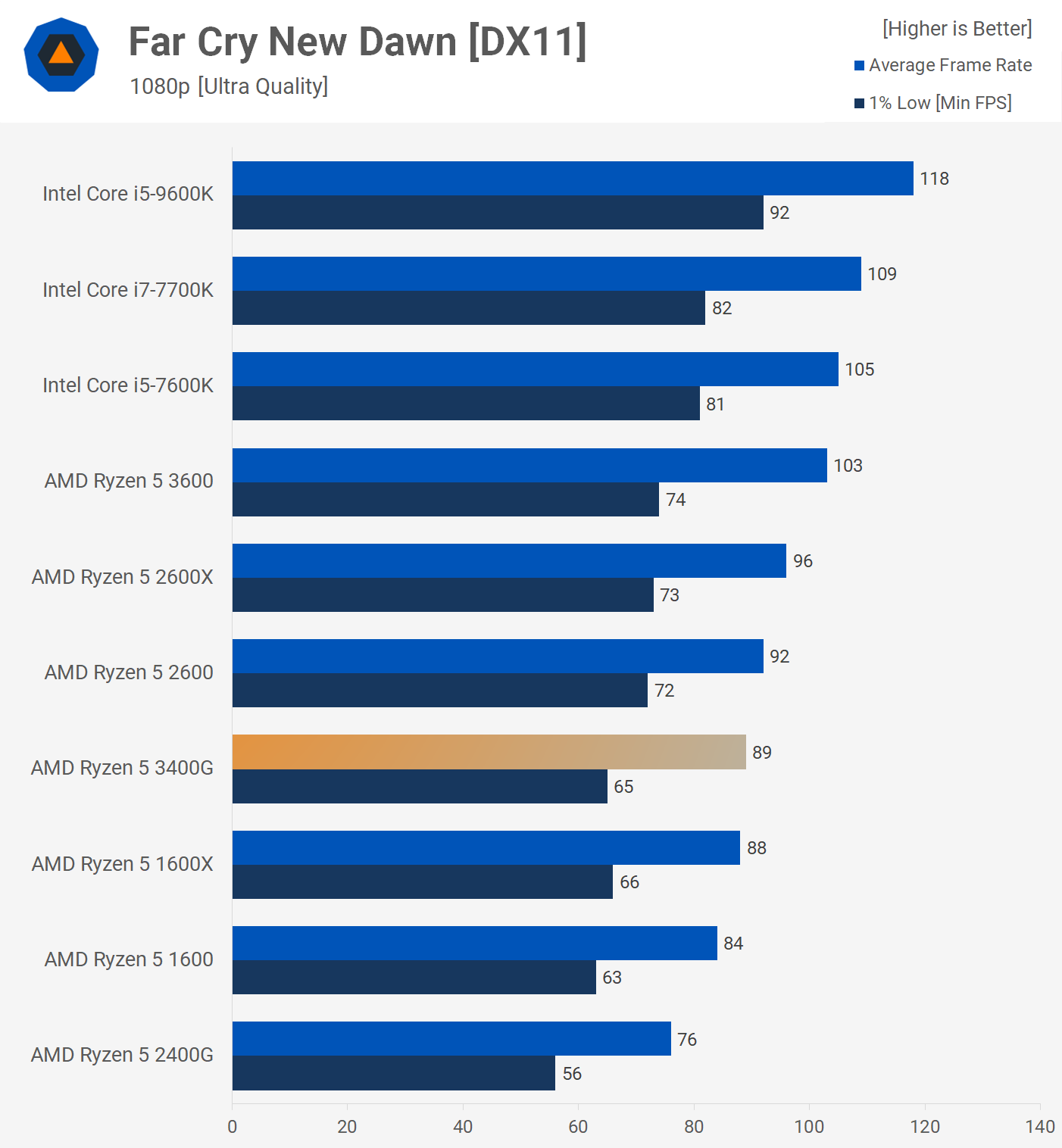
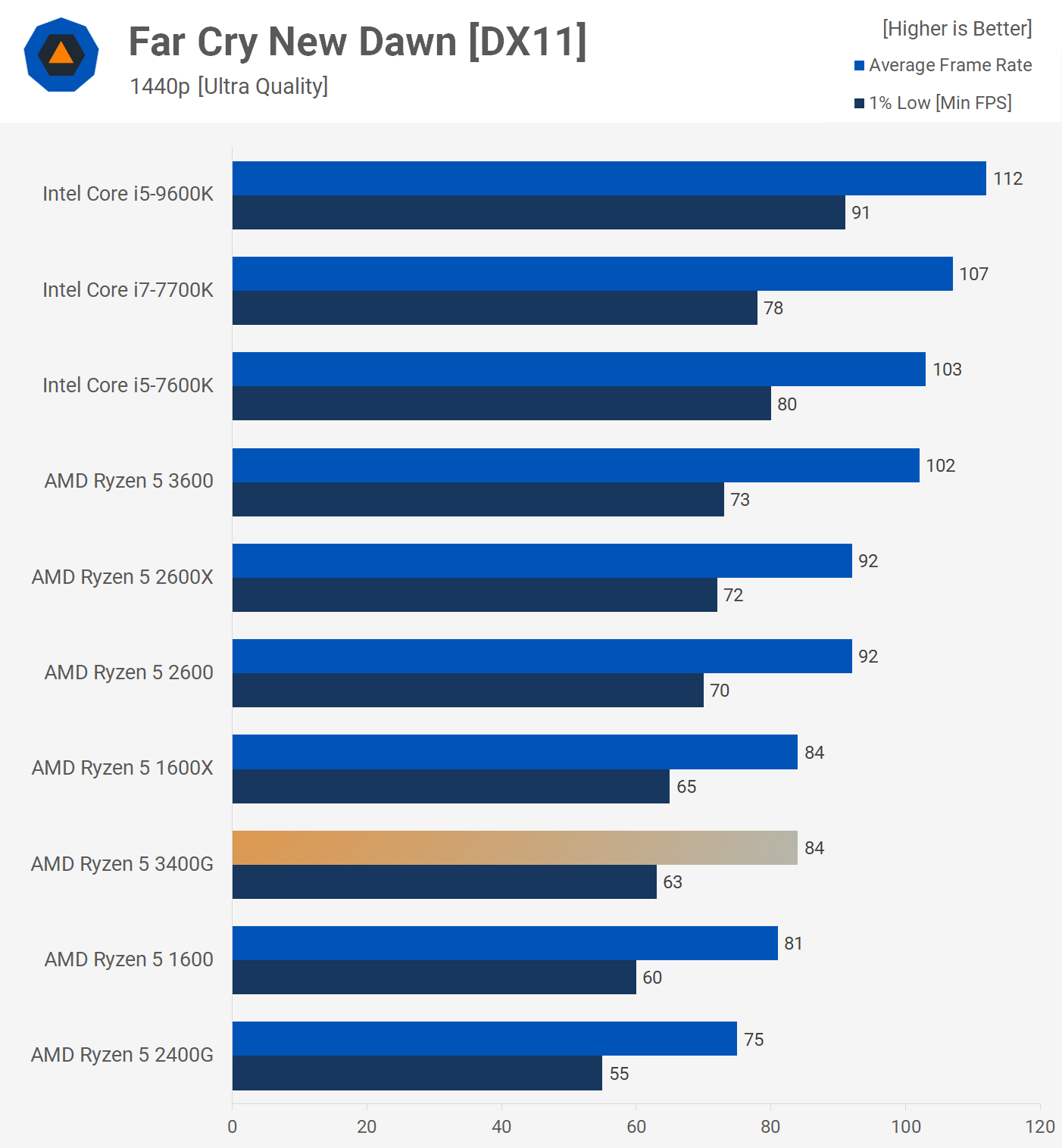
Gaming with the Integrated Vega 11 Graphics
Our first test shows a mere 5% improvement in performance over the 2400G. The good news is that the game was highly playable at 1080p, pushing well over 60 fps at all times.
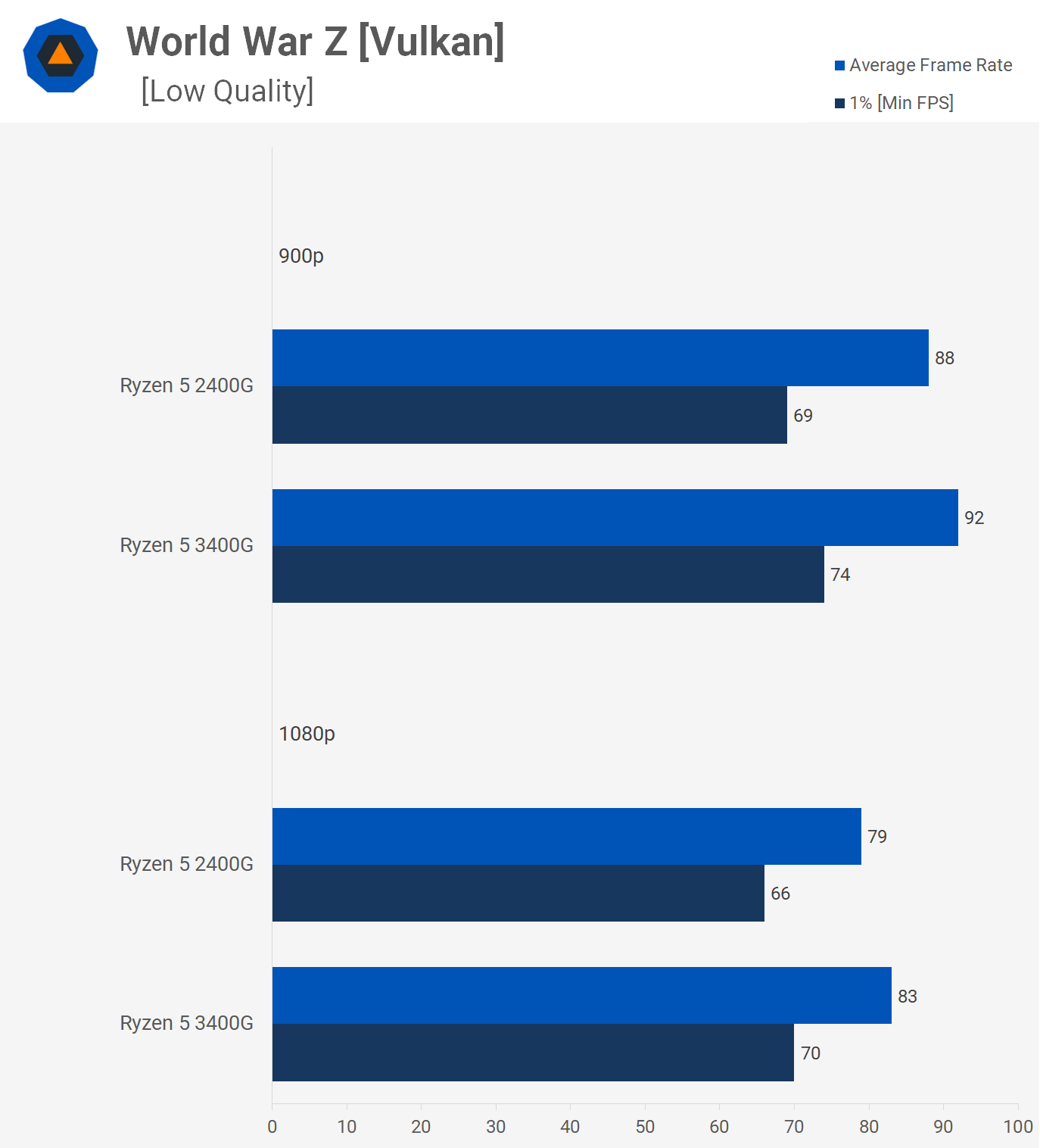
Next up we have Rainbow Six Siege and here the 3400G was up to 8% faster though both APUs performed very well, rendering over 60 fps, even at 1080p. Of course, we're using the lowest possible graphics quality preset, but for integrated graphics, that's still impressive.

Fortnite also plays well at 1080p but unfortunately the 3400G offered no real performance gain over the older 2400G in this title.
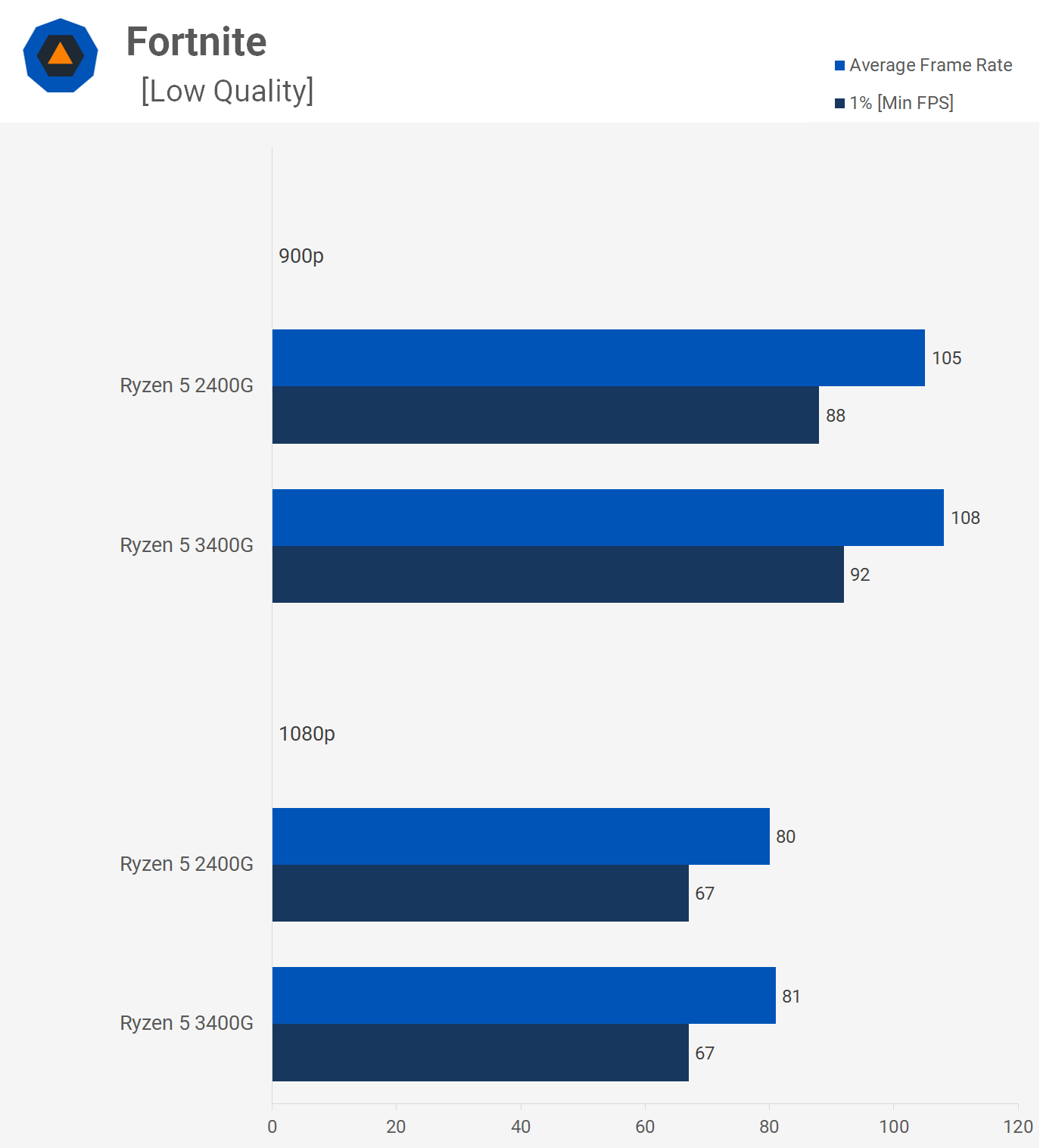
We see something similar in Far Cry New Dawn, despite the CPU side of the 3400G being much more punchy in this title, the Vega 11 overclock doesn't help here.

Next to no difference is seen in Strange Brigade, the 3400G provided a few extra frames but that was it.

Same goes for F1 2019. The 3400G is only good for a few extra frames, but the game was playable even at 1080p.

World of Tanks sees a 14% performance improvement when upgrading to the 3400G. This is a title that benefits from the Zen+ improvements but isn't heavily GPU bound when using the integrated graphics, so it's a rare situation where the improved CPU performance can be utilized in-game with the Vega 11 graphics.

Who Is It For?
When AMD released the first Zen-based APUs in February of last year it was an exciting time for these products to hit shelves. At the time graphics card pricing was heavily inflated due to mining demand, even if you were prepared to spend three or four times more than you should, shelves were empty to get you a new GPU.
The 2400G and 2200G gave gamers on a budget an alternative. The APUs would let you play games, albeit with low quality visuals, but they gave you the ability to play and then upgrade to a discrete graphics card later. Today though, we have no such issue. The second-hand graphics card market is thriving and you can buy a new Radeon RX 570 for as little as $130 and that will enable a vastly superior gaming experience. It's like comparing chalk and cheese.
The Ryzen 5 3400G will set you back $149, meaning the APU option remains relatively cheap for those buying new hardware, but we feel in today's market it will be relegated to be a niche product.
If your primary interest is gaming, a Ryzen 3 1200 for $65 new with an RX 570 for $130 or a second-hand model for $60, will be a significantly better gaming combo. Comparing to 'new' pricing, for just 30% more you'll see over 200% more performance. But if you're willing to shop used on the graphics card, the combo will be cheaper than just buying the 3400G.
For heavy productivity work, the 3400G isn't a cost effective option either. Instead you're better off with the Ryzen 5 1600 for $105 and pair it with a dirt-cheap discrete graphics card. You'll be able to get something with the $45 leftover.
If all you want is a basic PC for office-type work, then the 3400G is suitable. Likewise, if you're building a compact home theater PC and gaming isn't the focus, the 3400G is a really nice option, too. Beyond that, you're better off with other alternatives as we just mentioned. The previous-gen 2400G can also be had for $100 right now and considering the the 3400G was never 50% faster, we'd probably just get the 2400G and pocket the extra cash, save that for a better graphics card in the future if gaming is at all in your plans.
Shopping Shortcuts:
- AMD Ryzen 5 3400G on Amazon, Google Express
- AMD Ryzen 5 3600 on Amazon, Google Express
- AMD Ryzen 5 3600X on Amazon, Google Express
- Intel Core i5-9400F on Amazon, Google Express
- AMD Ryzen 5 2600X on Amazon, Google Express
- GeForce RTX 2060 Super on Amazon, Google Express
- GeForce GTX 1660 Ti on Amazon, Google Express
